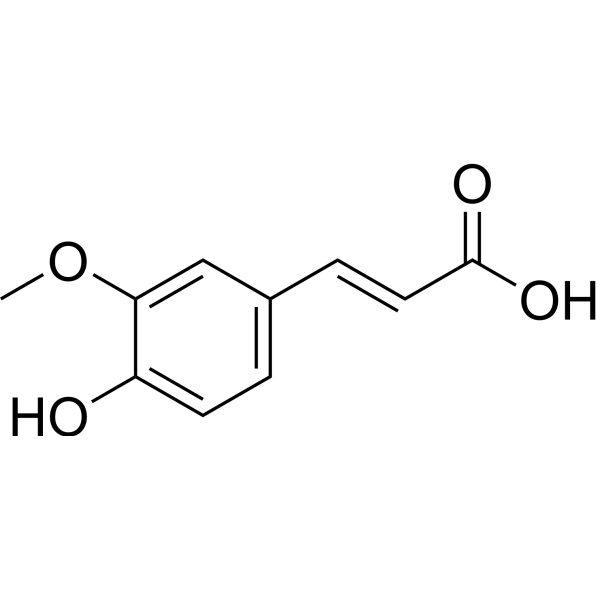All AbMole products are for research use only, cannot be used for human consumption.

For this product's availability, delivery time and price, please email [email protected] directly or click the "Inquiry Now" button below.
(E)-Ferulic acid is a isomer of Ferulic acid which is an aromatic compound, abundant in plant cell walls. (E)-Ferulic acid causes the phosphorylation of β-catenin, resulting in proteasomal degradation of β-catenin and increases the expression of pro-apoptotic factor Bax and decreases the expression of pro-survival factor survivin. (E)-Ferulic acid shows a potent ability to remove reactive oxygen species (ROS) and inhibits lipid peroxidation. (E)-Ferulic acid exerts both anti-proliferation and anti-migration effects in the human lung cancer cell line H1299.
| Molecular Weight | 194.18 |
| Formula | C10H10O4 |
| CAS Number | 537-98-4 |
| Form | Solid |
| Solubility (25°C) | DMSO 100 mg/mL (ultrasonic) |
| Storage |
Powder -20°C 3 years ; 4°C 2 years In solvent -80°C 6 months ; -20°C 1 month |
[4] Xiang Yuan, et al. Nat Prod Res. Phenolics from Lagotis brevituba Maxim
| Related Wnt/beta-catenin Products |
|---|
| (9Z,12Z,15Z)-N-[(3-Methoxyphenyl)methyl]-9,12,15-octadecatrienamide
(9Z,12Z,15Z)-N-[(3-Methoxyphenyl)methyl]-9,12,15-octadecatrienamide is a macamide isolated from Maca (Lepidium meyenii Walp). (9Z,12Z,15Z)-N-[(3-Methoxyphenyl)methyl]-9,12,15-octadecatrienamide induces mesenchymal stem cells osteogenic differentiation and consequent bone formation through activating the canonical Wnt/β‐catenin signaling pathway. |
| F7H
F7H is a Frizzled receptor FZD7 antagonist with IC50 of 1.25 μM. F7H is a potent ligand for the FZD7 transmembrane domain (TMD). |
| UU-T02
UU-T02 is a novel potent, selective small-molecule inhibitor of β-Catenin/T-cell factor protein-protein interaction, with a Ki of 1.36 μM. UU-T02 inhibits canonical Wnt signaling. |
| Wnt/β-catenin agonist 1
Wnt/β-catenin agonist 1 is a Wnt/β-catenin signalling pathway agonist, with an EC50 of 0.27 μM. |
| Calphostin C
Calphostin C (PKF115-584) is a small molecule inhibitor of Wnt/beta-catenin/lef-1 signaling. Calphostin C is also a potent and specific inhibitor of protein kinase C. PKF115-584 efficiently killed CLL cells (LC(50)<1 microM), whereas normal B cells were not significantly affected. |
All AbMole products are for research use only, cannot be used for human consumption or veterinary use. We do not provide products or services to individuals. Please comply with the intended use and do not use AbMole products for any other purpose.


Products are for research use only. Not for human use. We do not sell to patients.
© Copyright 2010-2024 AbMole BioScience. All Rights Reserved.
